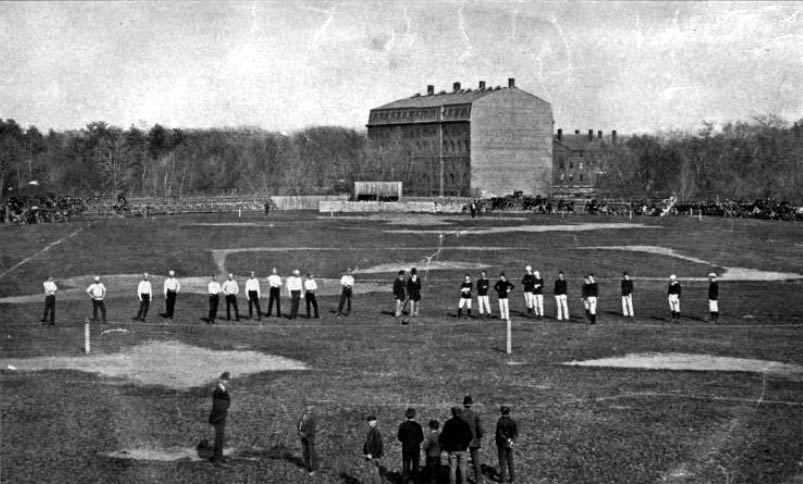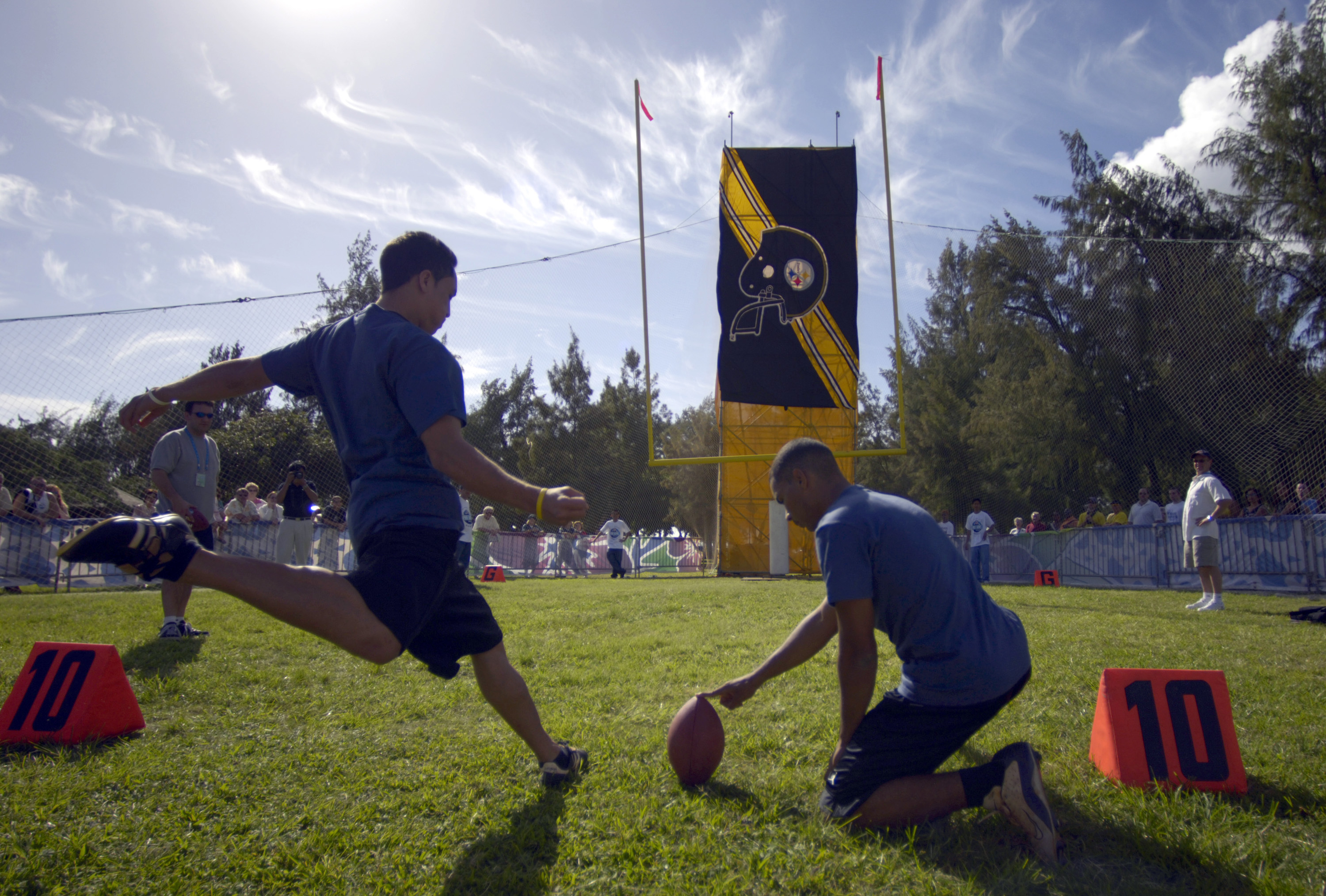|
Norm Bulaich
Norman Batton Bulaich ( ;Maule, Tex. "They Had Better Be Super," ''Sports Illustrated'', November 8, 1971. Retrieved October 14, 2020 born December 25, 1946) is an American former professional player who was a in the (NFL). Early life Bulaich was born on |
Running Back
A running back (RB) is a member of the offensive backfield in gridiron football. The primary roles of a running back are to receive American football plays#Offensive terminology, handoffs from the quarterback to Rush (American football)#Offense, rush the ball, to line up as a receiver to catch the ball, and Blocking (American football), block. There are usually one or two running backs on the field for a given play, depending on the offensive formation. A running back may be a Halfback (American football), halfback (in certain contexts also referred to as a "tailback" — see #Halfback/tailback, below), a wingback (American football), wingback, or a Fullback (American football), fullback. A running back will sometimes be called a "feature back" if he is the team's key player/more prominent running back. With the increase in pass-oriented offenses and single set back formations, it is more common to refer to these players as simply running backs. Halfback/tailbac ... [...More Info...] [...Related Items...] OR: [Wikipedia] [Google] [Baidu] |
1970 NFL Draft
The 1970 NFL draft was the 35th National Football League draft and the first of the league's modern era, following the merger of the National Football League with the American Football League. It was held on January 27–28, 1970, at the Belmont Plaza Hotel in New York City, New York (state), New York. The List of first overall National Football League Draft picks, first overall pick of the draft was quarterback Terry Bradshaw from Louisiana Tech University, who was taken by the 1970 Pittsburgh Steelers season, Pittsburgh Steelers (after winning a coin flip with the Chicago Bears, who had the same record as Pittsburgh). Bradshaw was one of two future NFL Hall of Fame inductees drafted by the Steelers; the other being Mel Blount from Southern University in Round 3. The last remaining active player from the 1970 draft class was kicker Mark Moseley, who played his final NFL game in the 1986 NFL season, 1986 season, although he was absent in 1973 NFL season, 1973. Player selections ... [...More Info...] [...Related Items...] OR: [Wikipedia] [Google] [Baidu] |
TCU Horned Frogs Football
The TCU Horned Frogs football team represents Texas Christian University (TCU) in college football at the NCAA Division I Football Bowl Subdivision (FBS). The Horned Frogs play their home games in Amon G. Carter Stadium, which is located on the TCU campus in Fort Worth, Texas, Fort Worth. TCU began playing football in 1896 and has been a member of the Big 12 Conference since 2012. The Horned Frogs claim national championships in 1935 TCU Horned Frogs football team, 1935 and 1938 TCU Horned Frogs football team, 1938, when they were led by Pro Football Hall of Fame quarterback Sammy Baugh and Heisman Trophy winner Davey O'Brien, respectively. TCU has had six other Heisman finalists. In addition to Baugh and O'Brien, TCU has had six other former players inducted into the College Football Hall of Fame. Following decades of futility during the late 20th century, TCU returned to national prominence under head coach Dennis Franchione (1998-2000). Franchione led the Horned Frogs to their ... [...More Info...] [...Related Items...] OR: [Wikipedia] [Google] [Baidu] |
College Football
College football is gridiron football that is played by teams of amateur Student athlete, student-athletes at universities and colleges. It was through collegiate competition that gridiron football American football in the United States, first gained popularity in the United States. Like gridiron football generally, college football is most popular in the United States and Canada. While no single governing body exists for college football in the United States, most schools, especially those at the highest levels of play, are members of the National Collegiate Athletic Association, NCAA. In Canada, collegiate football competition is governed by U Sports for universities. The Canadian Collegiate Athletic Association (for colleges) governs soccer and other sports but not gridiron football. Other countries, such as Organización Nacional Estudiantil de Fútbol Americano, Mexico, American football in Japan, Japan and Korea American Football Association, South Korea, also host colle ... [...More Info...] [...Related Items...] OR: [Wikipedia] [Google] [Baidu] |
Safety (gridiron Football Position)
Safety (S), historically known as a safetyman, is a position in gridiron football on the American football positions#Defense, defense. The safeties are defensive backs who line up ten to fifteen yards from the line of scrimmage. There are two variations of the position: the free safety (FS) and the strong safety (SS). Their duties depend on the defensive scheme. The defensive responsibilities of the safety and cornerback usually involve pass coverage towards the middle and sidelines of the field. While American (11-player) formations generally use two safeties, Canadian (12-player) formations generally have one safety and two Halfback (Canadian football), defensive halfbacks, a position not used in the American game. As professional and college football have become more focused on the passing game, safeties have become more involved in covering the Eligible receiver, eligible pass receivers.Safeties are the last line of defense; they are expected to be reliable tacklers, and many ... [...More Info...] [...Related Items...] OR: [Wikipedia] [Google] [Baidu] |
Punter (gridiron Football)
A punter in gridiron football is a special teams player who receives the snap (gridiron football), snapped ball directly from the line of scrimmage and then Punt (gridiron football), punts (kicks) the football to the opposing team so as to limit any field position advantage. This generally happens on a fourth down in American football and a third down in Canadian football. Punters may also occasionally take part in fake punts in those same situations, when they forward pass, throw or rush (gridiron football), run the football to get a first down instead of punting. Skills and usage The purpose of the Punt (gridiron football), punt is to force the team that is receiving the kick to start as far as possible from the punting team's end zone. Accordingly, the most effective punts land just outside the receiving team's end zone and land either Coffin corner (American football), out of bounds (making it impossible to advance the ball until the next play) or after being kicked excepti ... [...More Info...] [...Related Items...] OR: [Wikipedia] [Google] [Baidu] |
Placekicker
In gridiron football, the placekicker (PK), or simply kicker (K), is the player responsible for attempts at scoring Field goal (football), field goals and extra points. In most cases, the placekicker also serves as the team's kickoff specialist. The term derives from the attempted scorer kicking the ball "from placement" of a teammate holding the ball rather than by individually drop-kicking the ball through the goal posts. Specialized role The kicker initially was not a specialized role. Before the 1934 standardization of the spheroid, prolate spheroid shape of the ball, drop kicking was the prevalent method of kicking field goals and conversions, but even after its replacement by place kicking, until the 1960s the kicker almost always doubled at another position on the roster. George Blanda, Lou Groza, Frank Gifford and Paul Hornung are prominent examples of players who were stars at other positions as well as being known for their kicking abilities. When the one-platoon syst ... [...More Info...] [...Related Items...] OR: [Wikipedia] [Google] [Baidu] |
Big 33 Football Classic
The Big 33 Football Classic is an All-star game, all-star American football game featuring the top high school football, high-school football players in Pennsylvania. Played since 1958 in sports, 1958, the game is often described as the "Super Bowl of High School Football." Contests currently pit players from Pennsylvania against players from Maryland, but opponents in the past have also included players from Ohio and Texas. While most earlier games were held at Hersheypark Stadium in Hershey, Pennsylvania, the game is now played at Cumberland Valley High School in Mechanicsburg, Pennsylvania, Mechanicsburg. No Super Bowl has ever been contested without a Big 33 alumnus. While the game was originally played with the best 33 players in each state (hence its name), the organizers added a 34th player to give kickers a chance to be separate of the 33 count as to give one more non-kicker a chance to be named to the Big 33. Thus, there are 34 players from each state who are invited to ... [...More Info...] [...Related Items...] OR: [Wikipedia] [Google] [Baidu] |
Rush (gridiron Football)
Rushing is an action taken by the American football positions#Offense, offense, usually by the running back, but it can also be by the quarterback or wide receiver, that means to advance the ball by running with it, as opposed to forward pass, passing, or placekicker, kicking. Running Rushing, on offense, is running with the ball when starting from behind the line of scrimmage with an intent of gaining yardage. While this usually means a American football plays#Running plays, running play, any offensive American football plays, play that does not involve a forward pass is a rush - also called a run. It is usually done by the running back after a Handoff (American football), handoff from the quarterback, although quarterbacks and wide receivers can also rush. The quarterback will usually run when a passing play has broken down – such as when there is no receiver open to catch the ball – and there is room to run down the field. A team with a quarterback who is fast and skill ... [...More Info...] [...Related Items...] OR: [Wikipedia] [Google] [Baidu] |
All-America
The All-America designation is an annual honor bestowed on outstanding athletes in the United States who are considered to be among the best athletes in their respective sport. Individuals receiving this distinction are typically added to an All-America team for their sport. Some sports have multiple All-America teams, and list the honorees as members of a first team, second team, or third team. All-America teams are composed of outstanding U.S. amateur athletes. Individuals falling short of qualifying for the honor may receive All-America honorable mention. The designation is typically used at the collegiate level, although, beginning in 1957, high school athletes in football began being honored with All-American status, which then carried over to other sports like basketball and cross-country running. The selection criteria vary by sport. Athletes at the high school and college level placed on All-America teams are referred to as ''All-Americans.'' Term usage Individuals ear ... [...More Info...] [...Related Items...] OR: [Wikipedia] [Google] [Baidu] |
Scholastic Corporation
Scholastic Corporation is an American multinational publishing, education, and media company that publishes and distributes books, comics, and educational materials for schools, teachers, parents, children, and other educational institutions. Products are distributed via retail and online sales and through schools via reading clubs and book fairs. Clifford the Big Red Dog, a character created by Norman Bridwell in 1963, is the mascot of Scholastic. Company history Scholastic was founded in 1920 by Maurice R. Robinson near Pittsburgh, Pennsylvania to be a publisher of youth magazines. The first publication was ''The Western Pennsylvania Scholastic''. It covered high school sports and social activities; the four-page magazine debuted on October 22, 1920, and was distributed in 50 high schools. More magazines followed for Scholastic Magazines. In 1948, Scholastic entered the book club business. In the 1960s, international publishing locations were established in England (196 ... [...More Info...] [...Related Items...] OR: [Wikipedia] [Google] [Baidu] |







